Related Research Articles
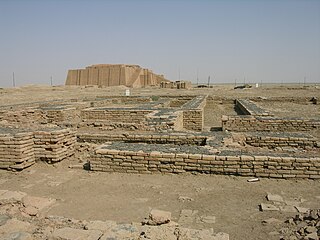
Ur was an important Sumerian city-state in ancient Mesopotamia, located at the site of modern Tell el-Muqayyar in south Iraq's Dhi Qar Governorate. Although Ur was once a coastal city near the mouth of the Euphrates on the Persian Gulf, the coastline has shifted and the city is now well inland, on the south bank of the Euphrates, 16 kilometres from Nasiriyah in modern-day Iraq.

Eridu is an archaeological site in southern Mesopotamia. Eridu was long considered the earliest city in southern Mesopotamia. Located 12 km southwest of Ur, Eridu was the southernmost of a conglomeration of Sumerian cities that grew around temples, almost in sight of one another. These buildings were made of mud brick and built on top of one another. With the temples growing upward and the village growing outward, a larger city was built. In Sumerian mythology, Eridu was originally the home of Enki, later known by the Akkadians as Ea, who was considered to have founded the city. His temple was called E-Abzu, as Enki was believed to live in Abzu, an aquifer from which all life was believed to stem.

The architecture of Mesopotamia is ancient architecture of the region of the Tigris–Euphrates river system, encompassing several distinct cultures and spanning a period from the 10th millennium BC, when the first permanent structures were built in the 6th century BC. Among the Mesopotamian architectural accomplishments are the development of urban planning, the courtyard house, and ziggurats. No architectural profession existed in Mesopotamia; however, scribes drafted and managed construction for the government, nobility, or royalty.

A ziggurat is a type of massive structure built in ancient Mesopotamia. It has the form of a terraced compound of successively receding stories or levels. Notable ziggurats include the Great Ziggurat of Ur near Nasiriyah, the Ziggurat of Aqar Quf near Baghdad, the now destroyed Etemenanki in Babylon, Chogha Zanbil in Khūzestān and Sialk. The Sumerians believed that the Gods lived in the temple at the top of the Ziggurats, so only priests and other highly respected individuals could enter. Society offered them many things such as music, harvest, and creating devotional statues to leave in the temple.

Uruk was an ancient city of Sumer situated east of the present bed of the Euphrates River on the dried-up ancient channel of the Euphrates 30 km (19 mi) east of modern Samawah, Al-Muthannā, Iraq.

Nippur was an ancient Sumerian city. It was the special seat of the worship of the Sumerian god Enlil, the "Lord Wind", ruler of the cosmos, subject to An alone. Nippur was located in modern Nuffar in Afak, Al-Qādisiyyah Governorate, Iraq.
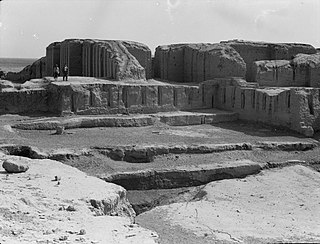
Kish is an important archaeological site in Babil Governorate (Iraq). It was occupied from the Ubaid to Hellenistic periods.

The First Babylonian Empire, or Old Babylonian Empire, is dated to c. 1894 BC – c. 1595 BC, and comes after the end of Sumerian power with the destruction of the Third Dynasty of Ur, and the subsequent Isin-Larsa period. The chronology of the first dynasty of Babylonia is debated as there is a Babylonian King List A and a Babylonian King List B. In this chronology, the regnal years of List A are used due to their wide usage. The reigns in List B are longer, in general.
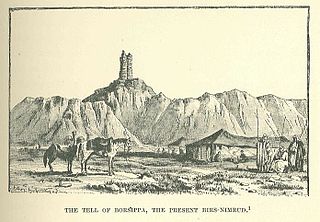
Borsippa or Birs Nimrud is an archeological site in Babylon Province, Iraq. The ziggurat is today one of the most vividly identifiable surviving ones, identified in the later Arabic culture with the Tower of Babel. However, modern scholarship concludes that the Sumero-Akkadian builders of the Ziggurat in reality erected it as a religious edifice in honour of the local god Nabu, called the "son" of Babylon's Marduk, as would be appropriate for Babylon's lesser sister-city.
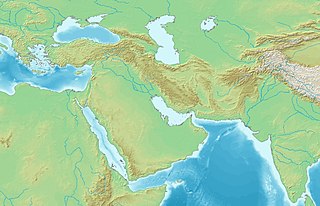
Elulu is listed as the third king of the First Dynasty of Ur on the Sumerian king list, which states he reigned for 25 years.
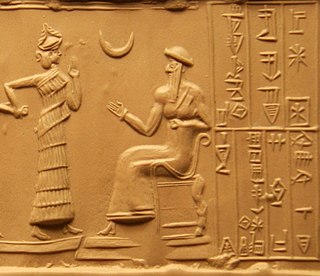
Ur-Nammu founded the Sumerian Third Dynasty of Ur, in southern Mesopotamia, following several centuries of Akkadian and Gutian rule. His main achievement was state-building, and Ur-Nammu is chiefly remembered today for his legal code, the Code of Ur-Nammu, the oldest known surviving example in the world. He held the titles of "King of Ur, and King of Sumer and Akkad".

Shulgi of Ur was the second king of the Third Dynasty of Ur during the Sumerian Renaissance. He reigned for 48 years, from c. 2094 – c. 2046 BC or possibly c. 2030 – 1982 BC. His accomplishments include the completion of construction of the Great Ziggurat of Ur, begun by his father Ur-Nammu. On his inscriptions, he took the titles "King of Ur", "King of Sumer and Akkad" and "King of the four corners of the universe". He used the symbol for divinity before his name, marking his apotheosis, from the 23rd year of his reign.

Chogha Zanbil is an ancient Elamite complex in the Khuzestan province of Iran. It is one of the few existing ziggurats outside Mesopotamia. It lies approximately 30 km (19 mi) southeast of Susa and 80 km (50 mi) north of Ahvaz.

The Zigguratof Ur is a Neo-Sumerian ziggurat in what was the city of Ur near Nasiriyah, in present-day Dhi Qar Province, Iraq. The structure was built during the Early Bronze Age but had crumbled to ruins by the 6th century BC of the Neo-Babylonian period, when it was restored by King Nabonidus.

A step pyramid or stepped pyramid is an architectural structure that uses flat platforms, or steps, receding from the ground up, to achieve a completed shape similar to a geometric pyramid. Step pyramids are structures which characterized several cultures throughout history, in several locations throughout the world. These pyramids typically are large and made of several layers of stone. The term refers to pyramids of similar design that emerged separately from one another, as there are no firmly established connections between the different civilizations that built them.
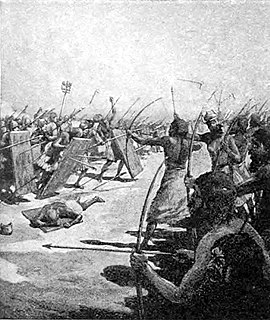
Lugal-Anne-Mundu was the most important king of the city-state of Adab in Sumer. The Sumerian king list claims he reigned for 90 years, following the defeat of Mesh-ki-ang-Nanna II, son of Nanni, of Ur. There are few authentic contemporary inscriptions for Lugal-Anne-Mundu's reign; he is known mainly from a much later text, purporting to be copied from one of his inscriptions.
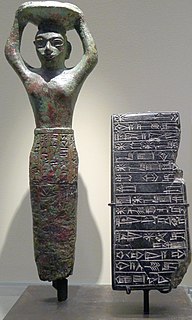
Amar-Sin, initially misread as Bur-Sin was the third ruler of the Ur III Dynasty. He succeeded his father Shulgi. His name translates to 'immortal moon-god'.

É is the Sumerian word or symbol for house or temple.

Kurigalzu I, usually inscribed ku-ri-gal-zu but also sometimes with the m or d determinative, the 17th king of the Kassite or 3rd dynasty that ruled over Babylon, was responsible for one of the most extensive and widespread building programs for which evidence has survived in Babylonia. The autobiography of Kurigalzu is one of the inscriptions which record that he was the son of Kadašman-Ḫarbe. Galzu, whose possible native pronunciation was gal-du or gal-šu, was the name by which the Kassites called themselves and Kurigalzu may mean Shepherd of the Kassites.

Neo-Sumerian art is a period in the art of Mesopotamia made during the Third Dynasty of Ur or Neo-Sumerian period, c. 2112 BC – c. 2004 BC, in Southern Mesopotamia. It is known mostly for the revival of the Sumerian stylistic qualities and was centered around royalty and divinity.
References
- ↑ Huth, Andrew (June 26, 2010). "Touring the Great Ziggurat of Ur". Army.mil . United States Army . Retrieved February 15, 2020.